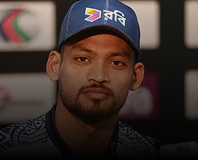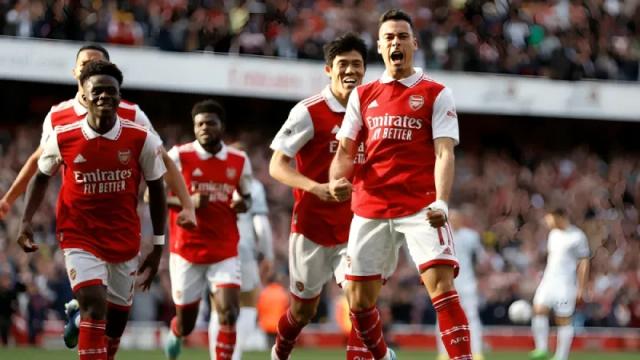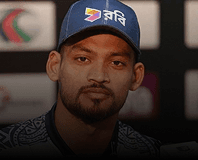


News

PUBLISHED ON: 30 SEP 2025, 08:44 AM
Former cricket greats came together for a special charity game, entertaining fans with nostalgic moments and brilliant strokes.

The 2025 tennis season is reaching a thrilling climax, and Coco Gauff is at the center of the excitement. At just 21, Gauff has already captured major titles, stunned audiences, and established herself as one of the game’s rising stars. As she heads into the prestigious season-ending event in Riyadh, expectations are sky-high, and the stage is set for one of her most important tournaments yet.
Gauff’s remarkable rise in 2025 has been fueled by consistent excellence. From winning a Grand Slam to dominating multiple hard-court finals, she has demonstrated skill, determination, and maturity beyond her years. Tennis legend Martina Navratilova even praised Gauff’s backhand, suggesting it could rival the power of Novak Djokovic’s—an extraordinary compliment that underscores the world’s attention on her.
“This year, Coco has shown a blend of talent, grit, and tactical intelligence that makes her a formidable opponent on any surface,” Navratilova remarked.
The season finale in Riyadh features the world’s top players competing for a massive prize pool of USD 5.15 million in singles alone. The compact, high-pressure format leaves little room for error, making it a true test of skill, strategy, and mental toughness. For Gauff, this tournament is an opportunity to cement her place among tennis’s elite.
Gauff’s threat on the court comes from a combination of technical skill, mental resilience, and youthful energy:
Despite her form, Gauff faces tough hurdles in Riyadh. The short turnaround between matches, elite opposition, and pressure of being a frontrunner require focus, stamina, and strategic planning. Any misstep could be costly in such a tightly contested event.
Coco Gauff enters Riyadh carrying the momentum of a season defined by skill, breakthrough victories, and unshakable belief. If she performs at her peak, she could not only claim a major title but also signal the arrival of a new era in tennis.
12 hours ago
Read More
In a nail-biting match that kept supporters on the edge of their seats right until the last over, Australia beat India by 2 wickets in the second ODI at the Adelaide Oval to seal the three-match ODI series 2–0. It was one of those games replete with drama, momentum changes, and individual heroics the kind of game that reminds the sporting world why this rivalry is still one of the best in contemporary sport.
Australia Hold Their Nerve to Wrap Up Series
In pursuit of a 265-run target, Australia began cautiously but steadily, with openers Travis Head (28) and Mitchell Marsh (11) building a solid platform. Wickets were lost in clusters in the middle overs, but Matthew Short produced an unlikely hero act, taking Australia home with an undefeated 74 from 78 balls, ably supported by Cooper Connolly (61)* in a determined ninth-wicket partnership.
The hosts finally achieved the target in the 49th over, and there were celebrations all around the Adelaide filled stands.
Australia’s win also highlighted the depth and calmness of their lineup, especially the lower order’s pressure-reliability — a signature of this world-class team.
India Fight Hard But Fall Short
After winning the toss, India chose to bat first and managed 264/9, a respectable total that fell 20 runs short on a batting field that was conducive to scoring.
While Shreyas Iyer (61) and Axar Patel (44) made timely runs, captain Rohit Sharma continued to play well, scoring 73 off 97 balls. But India again lost their key wickets in the final overs, as Australia’s bowlers applied pressure towards the end.
Leg-spinner Adam Zampa was the best bowler with 4 for 60, keeping India from running away with the game.
Turning Point: Fielding Blunders Cost India Precious
Fielding was India’s downfall. Two abandoned catches — one off Connolly on 24 and the other off Matthew Short on 55 — proved to be match-winners.
Post-match, Indian captain Shubman Gill, who had captained the team in the absence of Rohit for a while on the field, conceded:
“We were some 15–20 runs short and didn’t field well. In front of a team like Australia, little errors cost you big.”
The missed opportunities not only let Australia recover but also turned the momentum totally in their direction during the nail-biting closing stages.
India vs Australia Series Summary
| Match | Venue | Result |
| 1st ODI | Perth Stadium | Australia won by 5 wickets |
| 2nd ODI | Adelaide Oval | Australia won by 2 wickets |
| 3rd ODI | Sydney Cricket Ground | To be played (Oct 25, 2025) |
Now that the series is sealed, India has pride to play for in the final ODI, while Australia will seek to achieve a clean sweep on home turf.
What Lies Ahead
The loss serves to identify priority areas for improvement for India — death bowling, finishing power, and consistency in the field. Rotation of players and strength-testing of the bench will then be the focus ahead of 2025 Champions Trophy build-up.
Australia, on the other hand, appear a settled and assured unit, and their mix of experience and youth was their biggest strength going into next year’s world tournaments.
12 hours ago
Read More
In a historic move for Asian sports, the Philippines has been officially chosen to host the 2025 FIVB Men’s Volleyball World Championship, the first time the country will stage one of volleyball’s most prestigious tournaments. The announcement from the Fédération Internationale de Volleyball (FIVB) has generated widespread excitement among Filipino fans and the global volleyball community alike.
This will mark the first-ever Men’s Volleyball World Championship to be held in the Philippines, a nation with a deep passion for the sport. The decision highlights the country’s growing influence in the international volleyball scene and its proven ability to host large-scale events successfully.
The 2025 edition will feature 32 of the world’s best men’s teams, competing for the ultimate prize in the sport. Matches are expected to be held in major cities including Manila, Cebu, and Davao, showcasing both top-tier athletic action and the country’s rich culture and hospitality.
The Philippine Volleyball Federation (PVF) expressed immense pride over the announcement. “This is not just a victory for volleyball, but a milestone for Philippine sports as a whole,” said PVF President Ramon Suzara. “Hosting the World Championship will inspire millions of young athletes and put our nation on the global volleyball map.”
The Philippines’ selection underscores Asia’s growing role in international volleyball. Following successful tournaments in Japan and Thailand in recent years, FIVB continues to expand its reach across the region, aiming to strengthen volleyball’s global fan base.
For local fans, the news has sparked an outpouring of enthusiasm on social media. The country’s strong volleyball following, bolstered by the success of leagues such as the Premier Volleyball League (PVL), ensures that local support for the event will be massive. Analysts predict record-breaking attendance and television viewership once the tournament begins.
Tourism officials also anticipate a surge of international visitors. With world-class teams, athletes, and fans expected to arrive, the event is set to provide a major boost to the economy, hospitality, and sports tourism industries.
Preparations are already underway, with the FIVB and local organizers working closely to finalize venues, logistics, and promotional campaigns. The Philippines aims to deliver a world-class tournament that reflects its growing commitment to sports excellence and innovation.
In line with FIVB’s sustainability goals, organizers are planning to incorporate eco-friendly practices such as renewable energy use, reduced plastic waste, and digital ticketing systems. Training facilities and fan zones are also being developed to give visitors a truly immersive experience.
The championship will take place from September 12 to 28, 2025, and will feature powerhouse nations such as Brazil, Poland, Italy, and the United States. For Filipino fans, the tournament represents more than just a sporting spectacle, it is an opportunity to see the world’s best athletes compete on home soil and inspire the next generation of players.
The 2025 FIVB Men’s Volleyball World Championship will be a defining moment for Philippine sports. Hosting the world’s most prestigious volleyball event is a testament to the country’s passion, readiness, and rising status on the international stage. Beyond the matches and medals, this historic event promises to unite fans, celebrate athletic excellence, and shine a global spotlight on the Philippines as a proud home of volleyball.
Disclaimer: The insights and narratives provided within this feature reflect the author’s exclusive analytical viewpoints. Readers are encouraged to assess thoughtfully, explore alternative perspectives, and derive their own strategic takeaways.
Elevate your fan experience with Sports Live Hub: Featured News—the curated destination spotlighting the most impactful stories in global sports. From star-powered profiles and game-changing innovations to deep-dive exclusives and narratives shaping the future of athletic excellence, we surface the content that truly moves the scoreboard.
Access the headlines that matter. Engage with the stories that inspire. Lead the fandom—only with Sports Live Hub!
6 days ago
Read More
The 2025 Asian Table Tennis Team Championships in Bhubaneswar saw high hopes for the Indian women’s team, but their campaign ended in heartbreak. In a nail-biting quarter-final, India went down 3‑2 to Singapore, marking an early exit from medal contention. Despite strong performances from key players, India was unable to capitalize on crucial moments.
India, seeded fourth, entered the match as favourites, but Singapore proved to be a formidable opponent. Star players Manika Batra and Yashaswini Ghorpade each secured a win for India, yet Diya Chitale, despite a promising 2‑1 lead in her match, lost both her rubbers. This narrow defeat highlighted challenges in maintaining momentum and closing out matches under pressure.
The match was defined by tense rallies and fluctuating fortunes. Singapore’s players remained composed on critical points, securing the victories that ultimately edged India out. The outcome reflected not just one pivotal match, but a recurring issue of inconsistency during key moments.
Adding to the challenges was the absence of Sreeja Akula, sidelined due to a hand injury. Her absence weakened India’s squad depth and strategic options, limiting the team’s ability to rotate players and adapt to Singapore’s tactics. Playing on home soil at Kalinga Stadium in Bhubaneswar, where crowd support could have provided an advantage, India could not convert familiarity into a winning edge.
India’s exit underscores broader concerns in women’s table tennis at the continental level. While individual talent and flashes of brilliance are evident, the team continues to struggle with mental toughness and strategic execution in tight matches. Regional powerhouses like China dominated the championships, winning both the men’s and women’s team titles, setting a benchmark for performance and consistency.
This quarter-final defeat serves as a critical moment for reflection. The coaching staff must focus on strengthening areas such as mental resilience, match-tempo management, and building greater depth across the squad. With upcoming global tournaments and Olympic qualifiers on the horizon, India has an opportunity to turn this disappointment into a springboard for improvement.
For the players, the key challenge is translating skill into results during high-pressure moments. The team must learn to manage tight matches with composure and decisiveness to compete effectively on the international stage.
India’s women’s team has the talent and ambition to compete at the highest levels, but skill alone is not enough. The 2025 Asian Table Tennis Team Championships highlighted the need for poise, strategic clarity, and the ability to close matches. For India to move from promising performances to medal-winning success, mastering the pressure moments is essential. Until then, India’s potential will remain on display, but its full promise is yet to be realized.
Disclaimer: The insights and narratives provided within this feature reflect the author’s exclusive analytical viewpoints. Readers are encouraged to assess thoughtfully, explore alternative perspectives, and derive their own strategic takeaways.
Elevate your fan experience with Sports Live Hub: Featured News—the curated destination spotlighting the most impactful stories in global sports. From star-powered profiles and game-changing innovations to deep-dive exclusives and narratives shaping the future of athletic excellence, we surface the content that truly moves the scoreboard.
Access the headlines that matter. Engage with the stories that inspire. Lead the fandom—only with Sports Live Hub!
1 week ago
Read More
Arsenal F.C. have surged to the top of the Premier League table following a crucial 2,1 victory over Aston Villa, marking a defining moment in their title pursuit. The result, coupled with slip,ups from rivals Manchester City and Liverpool, has given Mikel Arteta’s side a firm advantage as the 2025 season heads into its decisive stretch.
The Emirates Stadium was buzzing with belief as Arsenal displayed both resilience and tactical maturity. Captain Martin Ødegaard opened the scoring early with a stunning left,footed strike from outside the box, setting the tone for an assertive performance. Although Villa equalized through Ollie Watkins just before halftime, the Gunners refused to lose composure. In the 78th minute, Bukayo Saka found the net from close range, sealing three massive points for the North London side.
Under Mikel Arteta, Arsenal have transformed from an inconsistent, youthful side into a finely tuned title contender. The win over Villa highlighted not only their attacking flair but also the defensive solidity that has defined their rise. William Saliba and Gabriel Magalhães anchored the backline with composure, while Declan Rice controlled the midfield, neutralizing Villa’s counterattacks.
Arteta praised his squad’s discipline after the match, “We’ve learned how to manage tough moments. It’s not just about playing beautiful football anymore, it’s about controlling games and finding a way to win.”
The Spaniard’s leadership has built a culture of accountability and ambition, reminiscent of Arsenal’s glory days under Arsène Wenger. The team’s blend of youth and experience, featuring stars like Saka, Ødegaard, and Gabriel Jesus, has brought balance and hunger back to the Emirates.
While Arsenal celebrated, their title rivals stumbled. Manchester City were held to a frustrating 1,1 draw against Brighton, and Liverpool’s shock defeat to Brentford extended their poor run of form. These results leave Arsenal three points clear at the top, a position they haven’t held this securely in years.
Analysts point to Arsenal’s consistency as the key difference this season. Their ability to win narrow matches, something that eluded them in previous campaigns, has proven crucial. Every fixture now feels like a step closer to ending their two,decade Premier League title drought.
The atmosphere around Arsenal is electric. Fans are daring to dream again, sensing that this might finally be the season where years of rebuilding pay off. Yet, Arteta remains cautious. “We can’t get carried away,” he said. “There’s still a lot of football to play, and every point matters.”
Upcoming fixtures against Tottenham Hotspur and Manchester United will test Arsenal’s resilience. Both matches could prove decisive in shaping the title race as the season edges toward the new year.
If Arsenal maintain their current form and mental toughness, they could finally reclaim the Premier League crown. The next few weeks will define whether Arteta’s project reaches its long,awaited pinnacle or falters under pressure. But one thing is certain, Arsenal have made their intentions clear, they’re no longer chasing, they’re leading.
Arsenal’s latest win cements their place at the top and signals a team that has evolved beyond potential. With strong leadership, tactical discipline, and newfound belief, the Gunners are closer than ever to restoring their dominance in English football.
Disclaimer: The insights and narratives provided within this feature reflect the author’s exclusive analytical viewpoints. Readers are encouraged to assess thoughtfully, explore alternative perspectives, and derive their own strategic takeaways.
Elevate your fan experience with Sports Live Hub: Featured News—the curated destination spotlighting the most impactful stories in global sports. From star-powered profiles and game-changing innovations to deep-dive exclusives and narratives shaping the future of athletic excellence, we surface the content that truly moves the scoreboard.
Access the headlines that matter. Engage with the stories that inspire. Lead the fandom—only with Sports Live Hub!
1 week ago
Read More
Australia’s ODI tour of India is happening in the background, but the nation’s cricketing obsession is elsewhere in Perth, where the first Ashes Test looms and the selectors’ headache has reached migraine levels. With Pat Cummins almost certain to miss the opener, and Scott Boland primed to slot in, the spotlight has swung sharply toward the top order.
The batting equation that once felt settled is now a Rubik’s Cube. Marnus Labuschagne’s recall seems inevitable, Cameron Green’s batting position is a puzzle in motion, and Beau Webster’s all-round value keeps reshaping the team balance. Three possible XIs are on the table, all logical, all flawed in their own way. What follows isn’t just selection talk. It’s a referendum on how Australia wants to shape its next phase of Test cricket.
If selectors stick to minimal disruption, Labuschagne will open with Khawaja just as he did at Lord’s during the WTC final. It’s a move that honors form, loyalty, and the Australian way of “backing your best batters.” But here’s the catch: Labuschagne isn’t a natural opener.
Sure, Steven Smith insists “it’s not too different from batting three,” but cricket’s small margins often live in those differences; facing the new ball versus joining after 15 overs can be a world apart. Still, there’s method in the madness: Green stays at No. 3, Webster’s bowling lightens his workload, and the XI retains balance. If that’s the path Bailey’s panel takes, it’s the safe, traditional option, but one that banks on Labuschagne’s adaptability more than his preference.
Option two brings clarity for Marnus but chaos elsewhere. If he bats at his natural No. 3, Australia needs a fresh opener, and that’s where things get messy. Renshaw, Weatherald, and Konstas’ three names, one problem: none have truly nailed the door down.
A single Shield century or an ODI cameo might sway hearts, but history says selectors are cautious creatures before the Ashes series. Picking a new opener now would be brave or reckless, depending on how Perth goes. And if Green shifts back to six, Webster pays the price despite his all-around value. Australia gains batting comfort but loses its bowling cushion, a trade-off that could haunt them in five-day heat.
Then there’s the romantic option reshuffle, reset, and restore Smith at No. 3. He averages 67 there, after all. Green slides to No. 4, where he once made a commanding 174 against New Zealand. It’s an aesthetically satisfying lineup, old-school in rhythm, modern in flexibility.
But the emotional comfort of “Smith at three” comes with baggage. The team spent months experimenting with order and identity post-Warner. Constant shuffling risks breaking rhythm just as Green begins to own his new batting persona. As Smith put it: “Everyone can slot in anywhere.” True, but sometimes, constant slotting means no one feels truly settled.
Regardless of who is on the field at Perth, it will come down to faith, rather than how they have been playing. Labuschagne’s opening may seem like the easy way out; however, it is also a sign that the selectors are struggling with their decision-making process. Opening someone else could create chaos in the short term, yet possibly open up an opportunity for future success. Shifting Smith back into the batting order may solve one of your problems, but it creates two new ones.
Australia’s selection debate isn’t about who opens, it’s about who they’re willing to bet their batting future on.
Almost certain that his recovery timeline makes him doubtful for Perth, with Scott Boland expected to fill in.
His seam-bowling option allows Australia to balance workloads, especially while Cameron Green manages his return to full bowling fitness.
Yes. Strong Shield performances or standout knocks in the India ODIs could catapult someone like Renshaw or Weatherald into contention.
Disclaimer: The insights and analyses shared in this blog represent the author’s personal viewpoints and interpretations. Readers are encouraged to engage critically, explore diverse perspectives, and form their own conclusions.
Step into the action with Sports Live Hub—your all-access pass to the pulse of global sports. From live match coverage and expert opinions to trending stories and exclusive behind-the-scenes moments, we bring every play, player, and passion straight to your screen.
Stay connected. Stay competitive. Stay ahead—only on Sports Live Hub!
2 weeks ago
Read More
Two middle-order batsmen combined brilliantly, stitching together a partnership that completely shifted momentum.
1 month ago
Read More
A disciplined bowling unit restricted the opposition to a modest total, securing a tense but decisive win.
1 month ago
Read More
The opener set the tone early, smashing boundaries all around the park to reach his fifty in record time.
1 month ago
Read More
Former cricket greats came together for a special charity game, entertaining fans with nostalgic moments and brilliant strokes.
1 month ago
Read More
A disastrous batting collapse early in the innings left the team struggling, costing them an important game in the ongoing series.
2 months ago
Read MoreEnd of the page